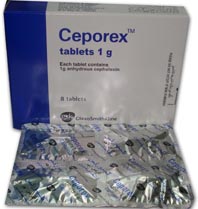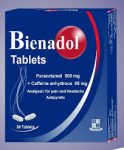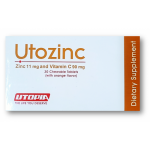
Ceporex
Cephalexin
CEPOREX” Cephelexin
Ceporex 250 mg film coated tablet
Cepcrex 500mg film coated tablet
Ceporex 1 9 film coated tablet
CeporexsyrUp125mg/5mlgranulesfororalsuspension
Ceporexsyrup 250 mg/5ml granules for oral suspension
QUALITATIVE AND QUANTITAIVE COMPOSITION :
Film coated Tablets contain either 250, 500 mg or 1 9 of cephalexin.
Granules for oral suspension: when reconstituted each 5 rnl contain
1395 mg Cephalexin monohydrate equivalent to 125 mg Cephalexin or 279.5 mg Cephalexin monohydrate equivalent to 250 mg Cephalexin.
list of Excipients :
Film coated Tablet: Magnesiun Stearate. Microcrystalline Cellulose,
aqueous film coat. Granules for oral suspension: sodium calcium Edetate – Acacia powder – Citric acid anhydrous – Soduim citrate anhydrous- Sunset yellow – Orange- bramble flavour polvaromas- Sucrose powder- water.
PHARMACEUTICAL FORM :
film coated tablets and granules for oral suspension
Indications :
CEPOREX is a bactericidal antibiotic which is active against a wide range of Gram-positive and Gram-negative organisms. It is indicated for treatment of the following conditions. when caused by susceptible bacteria. it is indicated for treatment of respiratory tract infections , urinary tract infections , skin and soft tissue infections, otitis media and other infections due to sensitive organisms
Dosage and Administration :
Route of Administration
for oral use. Orol formulations
Adults : The dosage is 1- 4 g daily in divided doses. Most infections wilt respond to 500 mg every a hours. For skin and soft tissue infections. streptococcal pharyngitis and mild uncomplicated UTls, the usual dosage is 250 mg every 6 hours or 500 mg every 12 hours. For more severe infections or those caused by less susceptfbte organisms, larger doses may be needed.
Children : The usual recommended daily dosage for children is 25-50 mg/kg in divided doses. For skin and soft tissue infections, streptococcal pharyngitis and mild. uncomplicated urinary tract infections, the total daily dose may be divided and administered every 12 hours. For most infections the following schedule is suggested:
Children under 5 years : 125 mg every B hours
Cbildren 5 years and over : 250 mg every a hours
In severe infections the dosage may be doubled. In the therapy of otitis media, clinical studies have shown that a dosage of 75-100mg/kg/day in 4 divided doses is required. In the treatment of beta-haemolytic streptococcal infections. a therapeutic dose should be administered for at least 10 days.
Elderly : The dosage is as for adults. The dosage should be reduced if renal function is markedly impaired.
Renal impairment : The dosage should be reduced if renal function is markedly impaired.
Hepatic impairment : There are no relevant data available.
Contraindications :
– Hypersensitivity to any ingredient of the preparation.
– Patients with known hypersensitivity to cephalosporin antibiotics.
Warnings and Precautions :
Special care is indicated in patients who have experienced an allergic reaction to penlclluns or other beta-tactams. As with other broad-spectrum antibiotics, prolonged use may result in the overqrowth of non-susceptible organisms (e.g.Candida, enterococci, Clostridium diffidlel. which may require interrupticn ot treatment. Pseudomembranous colitis has been reported with the use of
broad-spectrum antibiotics. therefore, it is important to ccnsld er its diagnosis in patients who develop severe diarrhoea during or
after antibiotic use. CEPOREX can interfere with the determination of the alkaline picrateassay for creatinine ,giving afalse high reading ,although this is unlikely to be of clinical importance. In patients receiving CEPOREX, a false-positive reaction forglucose in the urine maybe given, with Benedict’s or Fehling’s solution or with ‘Clinitest’ tablets. but not with enzyme-based tests. As with other antibiotics that are excreted mainly by the kidntys, when renal function is poor, dosagt of CEPOR£X should be suitably reduced (set Dosoge ond Administration).
Interactions :
Concurrent treatment with high doses of cephalosporins and nephrotoxic drugs such as aminoglycosides or potent diuretics ( e.g. frusemide.ethacrvnic acid and pirelanidel may adverstly effect renalfunclion.Clinical txperience has show nlhatlhis is not likely
10 be a problem with CEPOREX at the recommended dosage levels. In common with other antibiotics, cephalexin may affect the flora, leading to lower oestrogen reabsorption and reduced efficacy otocmbinec oral contra ceptives.
Pregnancy and lactation :
There is no experimental or clinical evidence of teratogenic eff ects attributable to cephalexln. but CEPOREX should be administered with caution during the early months of pregnancy. Cephaledn s excreted in human milk in low concentrations and
should be used with caution in nursing mothers.
Adverse Reactions :
lnfections andlnfestatlons
Common: Prolonged use can result in the overqrowth of Candida causingvulvo-vaginitis.
Blood and lymphatic system disorders
Common: Positive Coombs’ test
Rare: Reversible neutropenia
Very rare: Haemolytic anaemia.
Cephalosporinsasaclasstend tobe adsorbed onto the surface of red cell membranes. If antibodies directed against the drug are also present, this may result in reports of positive Cocmbs’ test (which can interfere with cross-matching of blood) and very rarely haemolvtlc anaemla.
Immune system disorders
Hypersensitivityreaclionsincluding:
Rare: AnaphylalCis
Very rare: Angioedema
Gastrointestinaldisorders
Common: Gastrcintestinal symptoms including nausea. diarrhoea
Uncommon: Vomiting
Very rare: Pseudomembranous colitis.
Skin and subcutaneous tissue disorders
Common: Drug rashes-both urticarial and maculopapular
Very rare: Severe skin reactions including toxic epidermal necrolysis (elCanthematic:necrolysis) ,StevensJohnson syndrome.
Renal and urinary disorders
Very rare: Reversible interstitial nephritis.
Overdose
Serum levels ot ceptelexln can be reduced by haemodialysis or by peritoneal dialysis.
Pharmacodynamics :
Bacteriology
Cephalexin is a bactericidal antibiotic: of the cephalosporin gro up which is active against a wide range of Gram-positive and Gram-negative organisms.
Gram-positive organisms Cephalexin is stable to staphvioccccel penicillinase and so is active against penicillin-resistant Staphylococcusaureusand other staphylococcal species (exciuding methiciltin-resistant isolat esl Streptococcus pyogenes, Streptococcus pneumonior:, Streptococcus ogoloctiae(Graup Bl.cther beta-haemolytic streptococci and most viridans group streptococci are also highly susceptible to
cephalexin. Grom-negotive organisms Cephaledn has in vitro activity against E. coli, K/ebsiel/aspecies, Protr:us mirobilis, Corynebocterium diphtheriar:. Solmonel/o and
Shigella species. Neisseria gonorrhor:ar: and N. mr:ningitidis are also susceptible.
Pharmacokinetics
Absorption
Oralcephalexin is almost completely absorbed in the upper portions of the gastrointestinal tract. Following oral administr atlon, absorption is rapid and peak serum levels (4.5 micrograms/ml for a 125 mg dose, 9 microgramsfml f0l’25O mg dose. 18 micrograms/ml for a 500 mg dose and 32 micrograms/ml for a 1000 mg dose) are usually reached at 1 h. In patients with normal renal function, serum levelsAbsorption isd(lay(d whencephalexln isgiv(n with or shortly after food, but the total amount absorve is not altered. Absorption of CfPOREXis not adversty afew (d by coeliac esease, partial gastr(ttomy, achlorhydria, jaundic( or diV(rticulosis (duod(nal orjtjunal).
Distribution
lhe dnq-protein binding is w(ak and rMrsibl(varying from Oto 3()qb according to the method otdeterminatton. C(phal(xin lswldelvdtstrfbuted in body tissues and high
ccncenuatlcns arefcund in all organs. particular/yth(liv(rand kidn(yS. Cephaluin ruches therapeutic lMIs in the blood. urine. blte. synovial fluid, pus, tonsillar tissue. amniotic fluid, cord blood and fOf:tal blood.
Metabolism
Cephakxin is not m(tabolis(d in the body.
Elimination
Ihe serum half-lirels ncrmallvabout t h.but is longer in the newborn (Re Dosag( and Administration). C(phaluin is eliminated by glom(rular filtration and tubular Rmtionr
Special Precautions for Storage
For storage: see ecter pact, f« granules for oral suspension: to be stored at tempreture not exceeding 30’C, after reconstitution it retains their potency for 7 days when stored at (2-S’C). lhe qranules fcr cral suspension maybe diluted with water (not
Syrup 8Pl, after which tnev shculd be used within seven days.
Nature and Contents of Container
CfPOREXfilm coated Tablet 250 & 500 mg: Carton box contains 2 strips PVC/At each of 6 toilbkts and infltl” leaflet. CfPOREXfilm coated Tablet 1 g: Carton box contains 2 strips PVCJAI pp tamper white closure withPVDC faced wad tiner& inner leaflet
[toform60mt)
Instrudions for Use/HOiIndling
tEPOREX syrups (grOilnules for oral suspensionl are prepared by: fill the measu,;ng cup to theline with water then add water to the )ottle in one go OiInd replace the cap, shOilke the bottle well to mix nedlcine properly to form Oral suspension containing
Manufactured by :
GIOiIxoSmithKline S.A.E. El Salam city-Cairo-Egypt
under license from Glaxo Wellcome – UK limited T/A Glaxo beratenes


